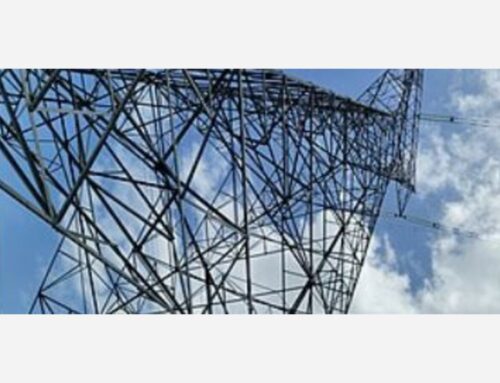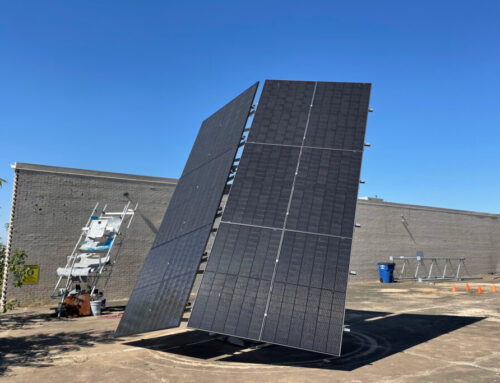Rondo Energy turns on first major thermal battery — at an oil field
October 22, 2025

But in the U.S., where the economics of replacing fossil fuels with electricity remain challenging, thermal-battery startup Rondo Energy has found its first industrial-scale opportunity in a more controversial place: the oil fields of California.
Last week, the San Francisco Bay Area-based firm announced the start of commercial operations for its first 100-megawatt-hour “heat battery,” located at a Holmes Western Oil Corp. facility in Kern County, the heart of the Central California oil patch.
The installation is housed in what looks like a four-story prefabricated office building. Inside sits a massive stack of refractory bricks, which are heated to temperatures of more than 1,000 degrees Celsius (1,832 degrees Fahrenheit) by an adjoining 20-megawatt solar array. That heat is tapped to generate steam that is injected into oil wells to increase production — a job previously done by a fossil-gas-fired boiler.
The project is something of a Faustian bargain. It will reduce carbon dioxide emissions by about 13,000 metric tons per year, said John O’Donnell, Rondo’s cofounder and chief innovation officer. But, of course, those reductions are in service of bringing more planet-warming fossil fuels to market.
Rondo’s argument for pursuing this application is twofold. For one, fossil fuels will be in use for decades to come, and so we might as well reduce emissions from the sector where we can. Second, thermal-storage startups need paying customers in order to scale up their technology, which could prove necessary to minimize pollution from a host of hard-to-decarbonize sectors.
“We’ve got to decarbonize the world the way it is right now,” O’Donnell told Canary Media in a Thursday call from the Washington, D.C., hotel hosting the annual summit of the Renewable Thermal Collaborative, a coalition of organizations working to cut emissions from heating and cooling. “And because California is kind of an island unto itself, we see this opportunity to make a very big impact in the state.”
Finding cost-effective projects in the U.S. has become even more important after the Trump administration canceled hundreds of millions of dollars in federal grants for industrial decarbonization efforts across the country. The defunded projects included ones that planned to use Rondo heat batteries: International spirits maker Diageo wanted to install the tech at its production sites in Illinois and Kentucky, while chemicals giant Eastman had agreed to add it to a plastics-recycling facility being built in Texas.
Those companies haven’t said if they plan to continue work on those projects absent federal funding, and O’Donnell declined to comment on their prospects. “We are ready to work with them when they’re ready to go,” he said.
But industry experts have pointed out that building first-of-a-kind thermal batteries is challenging without government funding to absorb some of the risk. The recent rollbacks jeopardize the U.S.’s ability to develop a technology that could play a major role in cleaning up industrial heating, which is responsible for roughly 13% of U.S. energy-related carbon emissions.
“Transitioning the world’s industrial economy to clean is going to take a minute — and by a minute, I mean multiple decades,” said Blaine Collison, executive director of the Renewable Thermal Collaborative. “This is a big shift that has to happen at a lot of discrete points. There are tens of thousands, hundreds of thousands of facilities that have to be addressed.”
Building a first-of-a-kind project
Rondo’s first 2-megawatt-hour pilot-scale heat battery started operating two years ago at a California ethanol-production facility. But that served more as a “constructability test” for the company’s technology than as a full-scale proof point for commercial viability, O’Donnell said.
Rondo’s Kern County battery, meanwhile, is its first major installation, though it has several others in the works across Europe. It’s building similar heat batteries at a chemicals plant in Germany, a green industrial park in Denmark, and an undisclosed food-and-beverage processing facility in Spain or Portugal.
The market for Rondo’s tech is stronger in Europe, where companies pay much higher prices for fossil gas and face sizeable fees and taxes on their greenhouse gas emissions, O’Donnell said. In the U.S., by contrast, fossil gas is cheap, and only a handful of states impose costs on industrial carbon emissions.
California is one of those states. Under its cap-and-trade program, industrial polluters must reduce their greenhouse gas emissions below certain thresholds — otherwise they have to pay fines or purchase offsets to make up the difference. And under the state’s Low-Carbon Fuel Standard, companies that produce and sell fossil fuels with lower embodied emissions can earn credits they can use to reduce compliance costs.
Still, even in more competitive markets like Europe and California, Rondo has additional work to do to hit its long-range cost goals. O’Donnell said the company is targeting $30 per megawatt-hour for the energy storage services its heat batteries provide, which would put it well within the range of lithium-ion batteries, albeit for a system that stores heat rather than electrical energy.
But the Holmes Western project is “not close” to that price point, he said. Rather, it’s “owned by the customer at a price point that was economical to them.”
Soaking up excess clean power with heat batteries
The holy grail for thermal storage — the thing that will make it broadly cost-competitive with fossil-fueled heating — is tapping into cheap, clean power.
That’s because the cost of electricity is ultimately what dictates whether a thermal battery makes financial sense. But unlike fossil fuels, electricity prices vary not just from week to week, but from hour to hour. That makes it tricky for would-be customers to evaluate whether to stick with a gas boiler or to make a bet on an electricity-powered system like Rondo’s.
Solar and wind, however, reliably generate power at a very low cost. In some parts of the U.S. and the world, the amount of renewable energy available exceeds electricity demand for hours at a time, driving wholesale power prices to zero or even negative.
Storing this excess carbon-free electricity as heat can significantly cut costs for owners of thermal storage systems, O’Donnell said. The challenge for providers of the tech is to get utilities, regulators, and energy-market operators to allow industrial customers to access those low or negative energy prices, O’Donnell said. Today, most industrial sites buy their electricity from utilities at retail rates that don’t pass through these wide wholesale fluctuations.
This is especially true in California, where thermal batteries are “in many ways the perfect solution,” said Teresa Cheng, California director at Industrious Labs, an advocacy group focused on cutting emissions from heavy industry.
Solar power is close to overtaking fossil gas as the state’s predominant source of electricity. Much of it is generated at times when there isn’t enough demand for electricity to use it or enough battery capacity to save it for later, forcing the state’s grid operator to curtail increasing magnitudes of solar.
Thermal batteries could soak up that cheap renewable energy while helping industries decarbonize, Cheng said. But “to make this work, we need state leaders to fix industrial electricity rates so they actually reward companies for using cheap, clean power instead of letting it go to waste.”
Holmes Western Oil Corp. is in an unusual position of owning enough land surrounding its facility to build its own 20-MW solar array without connecting to the grid. That “islanded” system allows the company to self-supply solar power at a cost that justifies the project, O’Donnell said.
But that’s a rare occurrence. Most industrial customers will need to source power from the grid — and opportunities for them to access electricity at wholesale prices are few and far between.
Doron Brenmiller, cofounder and chief business officer of Israel-based thermal energy storage provider Brenmiller Energy, said Europe is moving more quickly than the U.S. to support heat batteries, including a number of projects his company is building. He cited the European Commission’s upcoming $1.2 billion pilot auction to fund efforts to decarbonize industrial process heat.
“The utilities in Europe are also very engaged in this space,” he said. Brenmiller has partnered with German energy-trading firm Entelios to integrate its growing roster of industrial thermal storage projects into a variety of “short-term flexibility markets” for specialty grid services like frequency regulation and demand response.
But getting the first large-scale projects up and running remains the most important next step for the industry, he said. Brenmiller expects its first industrial-scale project, a 32-megawatt-hour thermal storage unit at a beverage-processing plant in Israel, to start operations before the end of 2025. A second 30-megawatt-hour system at a pet-food factory in Hungary is scheduled to begin running in 2026.
“All the eyes of clients and investors are on these first few big projects,” he said. “We’ve done pilots, even at scale. But these are the real thing.”
{
if ($event.target.classList.contains(‘hs-richtext’)) {
if ($event.target.textContent === ‘+ more options’) {
$event.target.remove();
open = true;
}
}
}”
>
Jeff St. John
is chief reporter and policy specialist at Canary Media. He covers innovative grid technologies, rooftop solar and batteries, clean hydrogen, EV charging, and more.
read next
Search
RECENT PRESS RELEASES
Related Post




